Poliscias flower: care and growing at home
Among domestic plants, you can sometimes find the most unusual specimens. These include poliscias - an evergreen plant whose branches grow up and can reach two meters at home. The foliage of different species varies so much in shape and color that it is difficult to classify them, at first glance, to one genus. We will get acquainted with the varieties of polyscias grown in houses, the optimal conditions for their maintenance and reproduction, and also learn how to properly care for them and avoid difficulties.
Botanical description of the plant
This evergreen perennial from the Aralian family has branched roots. In young stems, the color of the bark is gray-green, and in old, stiff, light brown tones. They are very flexible, they can even be tied into a knot, and this will not hurt them in any way. As the stem grows, the stem is exposed, and the poliscias becomes like a tree in a pot.
The shape of the leaves can be very different for different representatives of this genus. They can be round, narrow, cirrus, wide. The color of the foliage is green or mottled, with gloss. The plant blooms only in the natural environment with plain-looking umbrella inflorescences with small white flowers. After flowering, fruits are formed with a large number of seeds, quickly losing their ability to germinate.




















| Root system | Fibrous |
| Stem | Woody |
| Leaf shape | A wide variety of shapes |
| Color | Green or colorful |
| Flower shape | Shallow |
| Flower color | White |
The main types
This numerous genus includes more than 100 species, but only a few are used in indoor floriculture:
- Poliscias Balfour. This is a shrub with large (7 cm) lobed leaves. The foliage has an uneven green color with a white frame and spots of the same color.
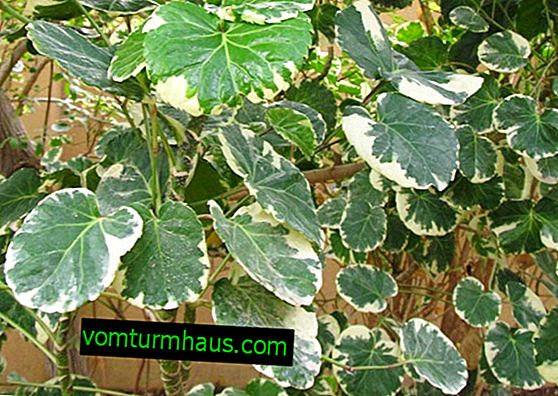
- Poliscias Guilfoyle. He has cirrus oblong leaves. Their color is heterogeneous - there is a border in white or yellow.
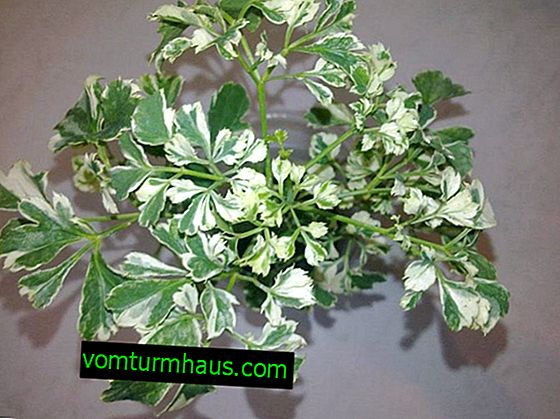
- Shrubby. This small branchy bush is similar to ferns, since its foliage consists of double-pinned and thrice-pinned leaves of a lanceolate or rounded shape.

- Paniculate. A small bush with large (15–20 cm long) leaves of a feathery-dissected configuration. The color of the foliage is light green, sometimes there are specimens with a narrow yellowish border.

- Fern-leaf (folisypholia). Its foliage is represented by long (30–50 cm) cirrus-dissected leaves tightly adjacent to each other.
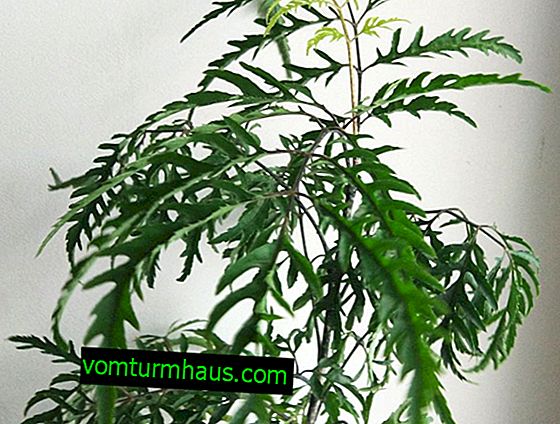
- Tupolistny. A bush with three-bladed leaves, rounded at the ends, which makes them somewhat similar to oak leaves.

- Helmet-shaped. It stands out among other species by its presence of a thick trunk and thin branches. The crown is well developed and leafy with white trim. Young leaves have a rounded shape, and over time they become three-lobed.

- Curly. A small, completely leafy bush. Cirrus dissected leaves are saturated green, sometimes have yellowish spots or a narrow light border.
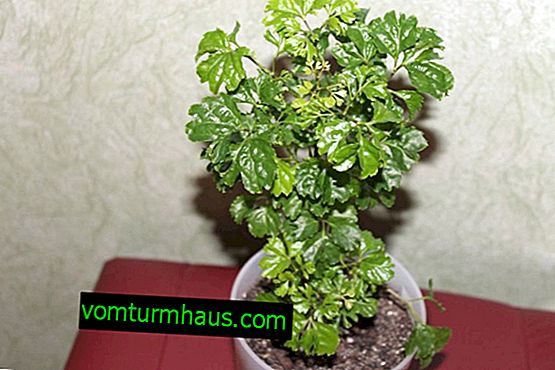
Conditions for successful growing at home
For polisias, you need to find a good place for its development and provide him with optimal conditions, then there will be no problems with him.
Location and Lighting
Lighting should be plentiful, but without direct sunlight, so window sills of windows on the western or eastern sides of the house are most suitable. However, during the period of the hot sun, poliscias will need to be shaded. In summer, it is recommended to transfer it to windows with an orientation to the north, and in winter, remove it from cold or through window sills and keep it away from heating appliances.
Important! Plants in the Araliaceae family, which include polysias, are toxic and can cause allergies or an eating disorder. They must be isolated from children and pets.
In winter, you should also provide good lighting, so during this period the plant is recommended to be illuminated with phytolamps until the summer day. The plant can tolerate partial shade and it will have enough light in 2.5–4 thousand lux. Varieties with monophonic leaves tolerate partial shade well, and plants with variegated foliage look more decorative in brighter light.
Temperature and humidity
The plant grows well in the temperature range from +18 to +24 ° C. The temperature in winter should not be below +17 ° C. Poliscias are plants of the Asian tropics and love high humidity. They are suitable for spraying and a warm shower. Plants are well placed next to fountains or containers of water. If it is not possible to often spray the flower, to saturate the environment with moisture, it is placed in a tray with wet pebbles, but note that the bottom of the pot should not come in contact with water.

Home Care
With proper care, the plant grows quickly and often reaches 1–2 meters in height.
Watering
It is necessary to water polisias moderately, as the top of the earth dries up. The earthen coma should not be allowed to completely dry out, but one should not overfill the plant or water it too often. In winter, watering is less common. Water the plant with well-protected water without chlorine, a little warmer than the temperature of the room where it grows. It would be nice to soften the water at the same time with vinegar or citric acid, as poliscias love soft water.
Did you know? An interesting shape can be achieved if the stems of the young polisces planted in the same pot are twisted with knots at the base. The nodes should be fixed with rubber bands, otherwise they will untie over time. If you then unravel them, the stems will look curly.
Top dressing
The plant must be fed 2 times a month during the growing season (May-August). To do this, take fertilizers for decorative foliage group. In winter, top dressing is reduced to once a month or completely stopped.
Pruning
Polisias are able to grow on their own, but with the help of proper molding and trimming, they can be given a more decorative look. It would be wise to trim too long bare plants. If you trim the top, it will awaken the side shoots. Pinching causes good branching. Typically, pruning is carried out in the spring, removing unnecessary or diseased branches.

Transfer
Plants are transplanted in the spring. Young transplanters need to organize an annual transplant, and old transplant every 3 years. For transplantation, prepare neutral or slightly acidic soil (universal or for citrus) and add perlite or sphagnum to it.
The main requirement for these mixtures is friability and nutrition. Such a soil mixture can be made with your own hands by mixing equal parts of humus, peat, leaf-sod land and sand. Then it should be poured with potassium permanganate or calcined in the oven for disinfection.
Find out how and when to transplant indoor plants.
The transplant itself is carried out by transshipment. The plant before this is abundantly watered. Too large specimens just change the top layer. For young plants, a container 10 cm larger than its roots is chosen. You can not transplant the plant into a too spacious pot, as excess soil can become acidic before it is mastered by the roots.
Be sure to make drainage from broken brick or expanded clay, pour a little soil on top and move the transplanted plant along with an earthen lump there. Then they fall asleep with the remaining soil and ram. A new plant can be rushed to replant if the pot is not small and the roots do not stick out from the surface of the earth.
Propagation by cuttings
The main method of propagating polyscias is cuttings. For breeding choose a strong and completely healthy instance. The process of reproduction is recommended to be done in early spring. For rooting, you can take both the young tops of the shoots, as well as older and woody branches.
The cuttings are cut approximately 10-15 cm in length. It is recommended to sprinkle the place of cut with charcoal and dry for 2–4 hours. If desired, cuttings can be treated with phytohormones or stimulants. Then the planting material is placed at a shallow depth in a mixture of sand and peat.

Important! When buying polyscias, you should stay on specimens with well-developed roots. But a plant with a luxurious crown should not be purchased, since stimulants were most likely used for this.
Growing difficulties
When growing polyscias, you may encounter the following difficulties:
- Dropping leaves. This situation often occurs in excessive light. The plant needs to be moved to a slightly shaded place, and the foliage periodically moisten with a spray bottle. It is worth noting that the problem of dropping leaves also occurs when the conditions of detention change (when moving, when changing the temperature and humidity, when drafts appear).
- Deterioration of variegation of leaves. May occur due to lack of light. If this happens in the winter, then you can use an artificial light source to eliminate such a nuisance.
- The leaves became brown. This often occurs with a lack of moisture. It is necessary to strengthen watering and be sure to spray.
- The appearance of brown plaques and sticky plaque on the leaves. Signals the appearance of scale insects. To get rid of this pest, the leaves are washed with soapy water and then treated with any insecticide.

- The appearance of cobwebs and white small spots. These are signs of a spider mite. To combat it, chemical preparations are used (Fitoverm, Actellik).
- Nematodes. These are small light worms about 1 mm in size. Such pests infect the leaves and roots of a plant. Unfortunately, it is impossible to get rid of them, you can only reduce their number. In this case, the plant is best disposed of so that the pests do not move to neighboring indoor flowers.
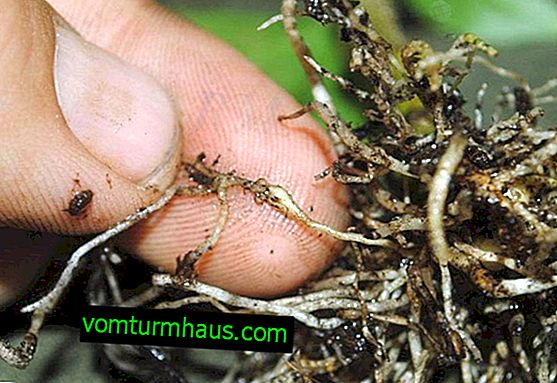
- The appearance of dark spots on the leaves. Signals the appearance of rot. The main cause of this problem is excessive moisture. Watering should be reduced and insecticides applied.
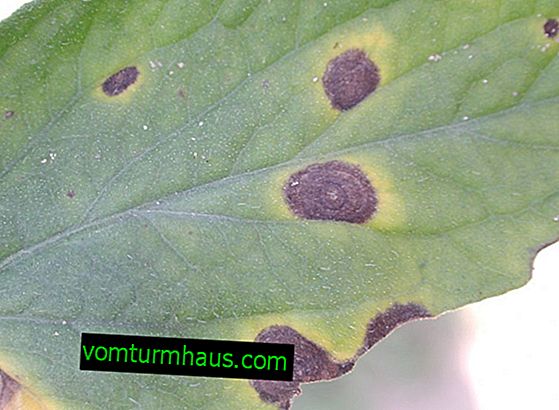
- Slowing down the growth and development of the plant. Occurs due to lack of nutrients. In this case, you need to make the appropriate feeding.
Plant energy
Esotericists believe that polisias in the house favorably affects its residents, because:
- strengthens the nervous system;
- increases resistance to infectious diseases;
- protects from radiation exposure.
Did you know? In esotericism, it is believed that invisible connections arise between a plant donated from the heart and its donor. If the polyscias for no reason began to fade or die, then you should find out if help is needed to the person who presented it.
Growing polyscias at home is not difficult. It is only necessary to provide this thermophilic plant with constant spraying and good diffused lighting all year round.














